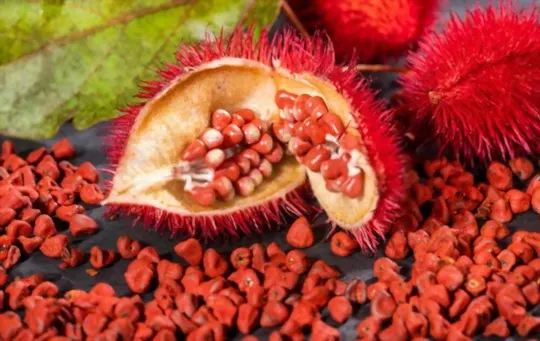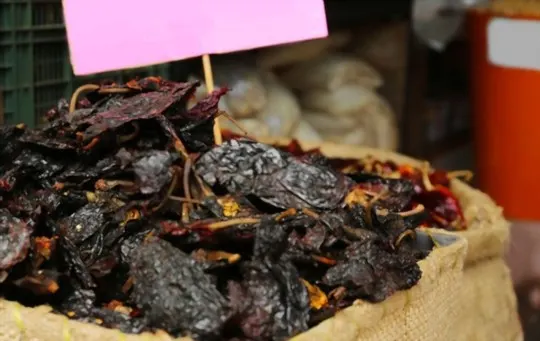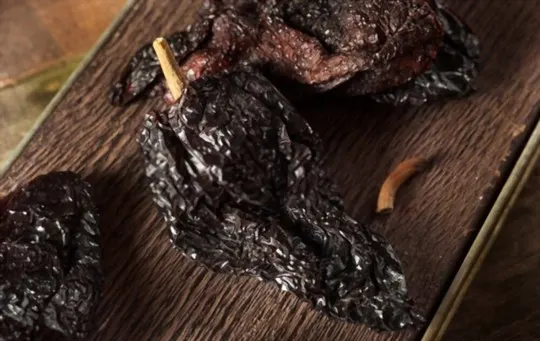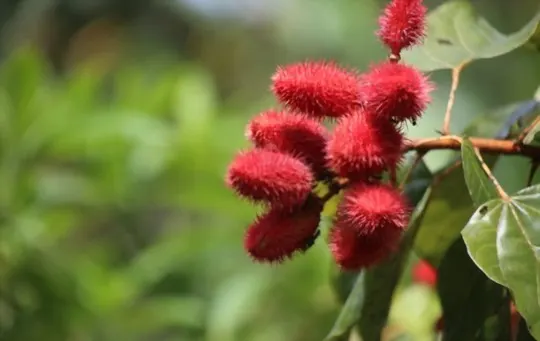Achiote and ancho are like distant cousins in the spice family. One’s vibrant and earthy; the other’s smoky-sweet. We’ve all had that moment—standing in the grocery aisle, achiote in one hand, ancho in the other, puzzled.
I remember the first time I concocted a dish, aiming for smoky but getting earthy instead. Learned the hard way, achiote isn’t ancho’s twin. Here’s the breakdown, no fluff.
Achiote, from the annatto seed, paints dishes in sunset hues. Ancho, a dried poblano, brings a depth of flavor. Mixing them up? Easy mistake. We’re here to clear the air.

What is Achiote?

Achiote is a spice made from the seeds of the annatto plant.
It adds vibrant orange-red color and nutty, slightly sweet flavor to dishes.
Achiote is commonly used in Latin American, Caribbean and Filipino cuisines.
It’s also known as annatto or bijol, and often used as a natural food coloring agent.
In dishes like cochinita pibil, a traditional Mexican slow-cooked pork dish, Achiote paste is rubbed onto the meat before cooking to impart its distinct flavor and color.
What is Ancho?

Ancho, a dry pepper commonly found in Mexican cuisine, is an essential ingredient for making different sauces and chilies.
With its wide range of deep flavors and moderate heat, it stands out from other chili peppers.
Its unique sweet and smoky taste comes from the drying process which concentrates its sugars.
Ancho’s wrinkled appearance is due to the dehydration process that dries out the flesh while retaining the seeds.
When cooking with Ancho, one should remove the stem and seeds before using it.
To prepare it, toast it on a hot skillet until fragrant but not burnt.
For best results, soak it in hot water or broth for around 20 minutes before blending it into a sauce or marinade.
Ancho’s mild heat makes it suitable for children and adults alike who cannot handle spicy food well.
Unlike chipotle and guajillo peppers which are spicier than Ancho, this pepper can be used daily without creating much heat in dishes.
Try adding Ancho to salsas, mole sauces, stews or use as a rub for meats such as beef or pork to add depth of flavor without overwhelming heat.
Differences Between Achiote and Ancho

Achiote and Ancho are two significant ingredients in many culinary cultures.
Achiote is a spice derived from the seeds of the annatto tree, while Ancho is a dried Poblano chili pepper.
Both are known for their earthy and slightly sweet flavors, but they differ in texture, aroma, and spiciness.
Origin and Source
A detailed understanding of the origin and source of spices is crucial in distinguishing between Achiote and Ancho.
The former has its roots in the American tropics, whereas the latter emerged from Mexico.
Achiote comes from the seeds of the Annatto tree while Ancho is a dried Poblano pepper that boasts a unique earthy flavour profile.
Both of these spices enrich dishes with their distinct tastes, but their origins can help guide recipe choices for different culinary spin-offs.
Appearance and Texture
The visual and tactile characteristics of these two popular spices differ significantly.
Achiote offers a red-orange hue due to the annatto seeds used, and has a slightly gritty texture due to its natural composition.
On the other hand, ancho boasts a deep maroon color and is mildly wrinkled in texture, owing to being dried poblano peppers.
You can easily distinguish them by color and feel.
While achiote’s grainy structure makes it perfect for use as a marinade due to its ability to cling well to meat, ancho’s smooth surface lends itself well to being turned into powders or flaked pieces.
Additionally, it has a unique flavor profile that sets it apart from its counterpart – earthy with hints of smokiness and moderate heat.
Achiote, by contrast, is more mild and sweet with subtle hints of citrus.
It’s important to consider both appearance and texture when selecting which spice is appropriate for your recipe.
For instance, while ancho performs well in sauces or dips, achiote would be ideal for infusing color or imparting flavor in dishes such as rice or fish fillets.
Keep these distinguishing features in mind when making your spice choices to achieve the right taste for your meal.
Flavor Profile
Achiote and Ancho are two distinct flavors found in Mexican cuisine.
Achiote, also known as Annatto, is a sweet and peppery spice with a slight earthy flavor and a vibrant red hue.
On the other hand, Ancho is a mild to moderately spicy dried chili pepper with fruity undertones and a smoky flavor profile.
When it comes to using Achiote and Ancho in cooking, there are some key differences to keep in mind.
Achiote is mainly used for adding color and flavor to dishes such as rice, meat stews, and marinades.
In contrast, Ancho is primarily used as a base ingredient for sauces, salsas, soups or as an alternative seasoning for meat dishes.
It’s worth noting that while both spices share some similarities in their unique blend of flavors, the intensity of their taste differs significantly.
Achiote has a more subtle taste which can be easily overwhelmed by other seasonings if used excessively whereas Ancho has an intense yet balanced flavor that can stand out on its own.
Usage in Culinary Traditions
Culinary traditions have long embraced the use of achiote and ancho in preparing various dishes.
These ingredients come from different sources but have unique characteristics that make them indispensable in some cuisines.
Achiote is known for its earthy flavor and reddish-orange hue, making it perfect for marinades and rubs.
On the other hand, ancho is a dried, mild chili pepper commonly used in Mexican cuisine to add depth to flavors and achieve a smoky profile.
Apart from their differences in taste and appearance, these spices can be used interchangeably in some recipes.
For example, substituting achiote with ancho or combining both can elevate your dishes to a whole new level of flavor complexity.
However, it’s essential to note that using both together may result in overpowering flavors that might throw off the dish’s balance.
Incorporating traditional ingredients into modern cuisine has brought about innovative ways of unlocking new savory blends, resulting in unique tastes while retaining familiar comforts.
Similarities Between Achiote and Ancho

Achiote and Ancho have certain similarities that make them confusing, but they differ in various aspects.
Both spices are used to enhance the flavor of food items.
They can be used as rubs or marinades and complement barbecue and grilled dishes effectively.
In terms of flavor, both Achiote and Ancho bring a unique taste to Mexican cuisine, adding warmth and depth in different ways.
Moreover, these spices aid greatly when it comes to adding color and aroma.
Although both have some similarities, Achiote is stronger than Ancho and has a more complex flavor profile with peppery and fruity notes.
Whereas, Ancho is milder but rich in fruitiness, perfect for spicy dishes without overpowering the other flavors.
Overall, both are great spices that can elevate any dish’s taste to whole new heights.
The perfect combination depends on the preference of the chef or cook who will be using them.
How to Use Achiote and Ancho in Cooking?
Achiote and Ancho are popular ingredients in Latin America that can add flavor and color to your dishes.
Achiote, also known as Annatto, has a nutty and slightly sweet taste with a bright orange-red color.
It is commonly used for marination, seasoning meat, and making paste.
On the other hand, Ancho is a dried Poblano chili pepper with a smoky and mild flavor that adds depth to stews, sauces, and soups.
It also gives a deep red-brown color to your dishes.
Both ingredients can be found at specialty stores or online retailers.
To use Achiote paste, mix it with orange juice or vinegar to create a marinade for grilled or roasted meat like chicken or pork.
For seasoning meat, rub the paste generously all over the meat before cooking it.
You can also mix Achiote paste into rice dishes like Arroz con Pollo for added flavor and color.
Ancho chili pepper can be rehydrated by soaking it in hot water for 15 minutes until softened, then blended into a sauce for enchiladas or drizzled over tacos.
An alternate way of using these ingredients is by using Ancho powder to add depth to spice blends, rubs or stews while Achiote powder can be used as a coloring agent to giving your dishes an earthy color without adding any distinct flavor.
Conclusion
Achiote and Ancho may seem similar, but they have distinct differences in flavor profiles and culinary uses.
Achiote has a citrusy flavor with earthy undertones and is used in Latin American dishes such as cochinita pibil.
On the other hand, Ancho has a sweet, smoky taste with hints of raisin and is commonly used in Mexican cuisine for dishes like tamales and mole sauce.
Both spices add depth to dishes, but understanding their unique qualities is essential when cooking.
It’s important to experiment with both spices to determine which one complements your recipe best.

Leave a comment